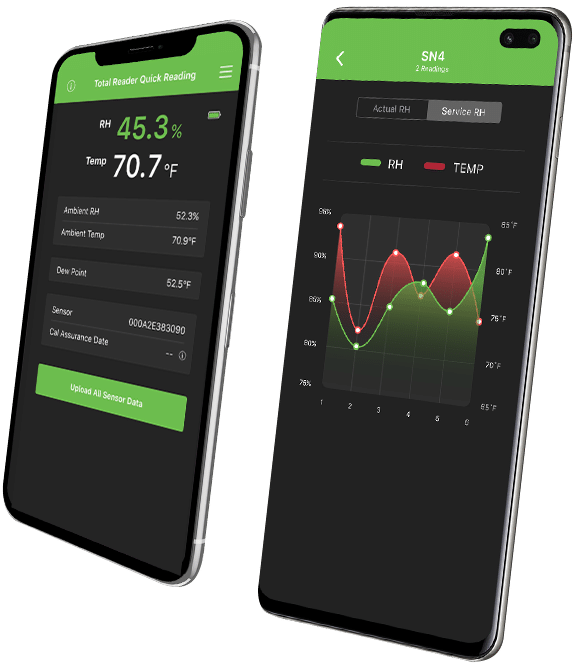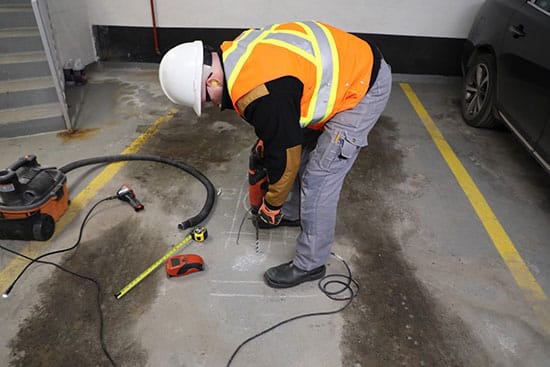Concrete Moisture Testing Checklist
Testing moisture in concrete slabs isn’t just a box to check—it’s crucial for preventing costly flooring failures. Whether you’re a flooring installer, contractor, or building inspector, following ASTM F2170 standards ensures accurate results, fewer delays, and long-lasting installations.
This checklist breaks down everything you need to do, step by step, in plain English—no confusing industry jargon.

The DataMaster app is a great place to record your data.
We’ll cover:
✅ How to set up proper service conditions before testing
✅ How many test holes you need for ASTM compliance
✅ Best practices for drilling, cleaning, and inserting sensors
✅ How to record and report results for documentation
By the end, you’ll have a foolproof system for moisture testing that saves time, reduces risk, and ensures a strong foundation for your flooring project.
Let’s get started.
Table of Contents
- Check service conditions
- Decide how many test holes you’ll need
- Determine test hole depth
- Drill and prepare holes
- Wait 24 hours
- Take RH measurements
- Record and report results
Under each step, we’ll cover everything you need to know. Ready?
1. Check Service Conditions
Before testing, you must make sure the environmental conditions are stable.
Why? Concrete moisture levels fluctuate based on temperature and humidity. If conditions aren’t stable, your test results will be inaccurate—leading to flooring failures down the road.
Steps:
2. Decide How Many Test Holes You’ll Need
ASTM F2170 requires a specific number of test holes to ensure reliable readings.
Time for some math! You’ll need three test holes for the first 1,000 square feet and at least one hole for each additional 1,000 square feet.
For a building with 3,000 square feet, that would be a total of 5 tests (3 for the first 1,000 square feet and 2 for the remaining 2,000 square feet).
Use the DataMaster app to record the area of the slab. Or write it down and keep it with job records.
3. Determine Test Hole Depth
If the slab is drying from one side, your test holes should be 40% of the depth of the slab. But if the slab is drying from both sides, your test holes only need to be 20% of the depth.
Record this slab thickness in the DataMaster L6 app or write it down.
4. Drill and Prepare Holes

Use a masonry drill bit to make the test holes, and don’t forget to vacuum them out.
Use a rotary hammer drill and a ¾”-diameter masonry drill bit to make all the test holes in the locations you decided earlier. Again, we recommend recording the locations of the holes—either on the app or manually.
Once all the holes are drilled, remove any dust with a shop vacuum, alternating with a wire bristle brush to loosen any debris.
Insert the sensor into the hole, making sure it sits all the way at the bottom.
5. Wait 24 Hours
RH sensors must equilibrate within the concrete before they provide accurate readings. Cover the sensor and allow it the required 24 hours to equilibrate.
6. Take RH Measurements
Once sensors are equilibrated, it’s time to take official RH readings. After equilibration, remove the cap and place the reader inside the sensor to take the readings.
7. Record and Report Results
Documentation ensures compliance, helps resolve disputes, and protects against liability. As you take readings, be sure to record your results with the date and test hole location. If you’re using Wagner’s DataGrabber with Bluetooth, results will automatically sync to the DataMaster app.
All Ready for Testing!
With these simple steps, you will have successfully measured the relative humidity of your concrete slab. But if you’re at all concerned about meeting standards, we encourage you to check out the ASTM F2170 checklist.
To make RH testing even easier, the DataMaster app connects with Rapid RH’s Smart Sensors, keeping all your important data in one place. It’ll save you time and the frustration of missing paper records! Download the app today.
Jason has 20+ years’ experience in sales and sales management in a spectrum of industries and has successfully launched a variety of products to the market, including the original Rapid RH® concrete moisture tests. He currently works with Wagner Meters as our Rapid RH® product sales manager.
Last updated on March 4th, 2025



